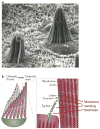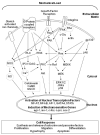Mechanotransduction gone awry
- PMID: 19197333
- PMCID: PMC2668954
- DOI: 10.1038/nrm2597
Mechanotransduction gone awry
Abstract
Cells sense their physical surroundings through mechanotransduction - that is, by translating mechanical forces and deformations into biochemical signals such as changes in intracellular calcium concentration or by activating diverse signalling pathways. In turn, these signals can adjust cellular and extracellular structure. This mechanosensitive feedback modulates cellular functions as diverse as migration, proliferation, differentiation and apoptosis, and is crucial for organ development and homeostasis. Consequently, defects in mechanotransduction - often caused by mutations or misregulation of proteins that disturb cellular or extracellular mechanics - are implicated in the development of various diseases, ranging from muscular dystrophies and cardiomyopathies to cancer progression and metastasis.
Figures





References
-
- Engler AJ, Sen S, Sweeney HL, Discher DE. Matrix elasticity directs stem cell lineage specification. Cell. 2006;126:677–89. - PubMed
-
- Paszek MJ, et al. Tensional homeostasis and the malignant phenotype. Cancer Cell. 2005;8:241–54. This paper presents an elegant study linking matrix stiffness and cytoskeletal tension to cancer progression. As a component of a “mechano-regulatory circuit” that includes integrins, Rho, and ERK, disruption of tensional homeostasis can promote malignant phenotype in a model of breast cancer. - PubMed
-
- Ingber DE. Cellular mechanotransduction: putting all the pieces together again. FASEB J. 2006;20:811–27. - PubMed
-
- Orr AW, Helmke BP, Blackman BR, Schwartz MA. Mechanisms of mechanotransduction. Dev Cell. 2006;10:11–20. - PubMed
-
- Vogel V, Sheetz M. Local force and geometry sensing regulate cell functions. Nat Rev Mol Cell Biol. 2006;7:265–75. This is a comprehensive review of the literature on how physical cues in the microenvironment of a eukaryotic cell are sensed and converted to biochemical signals that define cell shape and regulate cell growth, differentiation, and survival. - PubMed
Publication types
MeSH terms
Grants and funding
LinkOut - more resources
Full Text Sources
Other Literature Sources

